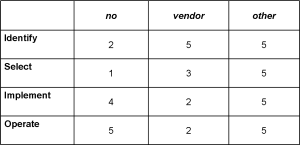Moving on to the implementation phase, some very clear patterns emerged. From the participants in this stage (N=8), the keywords were training, people and structure.
The strongest theme (from five of the participants) was a need to focus more on the related areas of training, end user adoption, change management and participant involvement. There was also a specific mention of a desire for more video instruction.
In a contrary to some findings in an earlier stage, one of these respondents also reported that they should have “concentrated more on IT Department involvement.”
Two respondents reported on a need for better structure and processes. One discovered a need for better processes, “particularly in requirements gathering, development and configuration management.” One of our inferences at an earlier stage was the benefit of starting with small projects, but the flip side to this approach was discovered by one participant – after purchasing a wiki to address a particular need, they:
“… then branched out with a few pilot uses, to see what would happen. We intended these to be small experiments, but they have grown a lot more than we expected and really need a bit more structure around them… a support plan would have been a very good idea!”
Our final participant reported that they should have done:
“Far more research on the product itself, and not be left with some nasty surprises once we got down to detailed planning, especially around a) Information Architecture constraints, and b) mapping business governance to the complex demands of the software.”
There seems to be some paradoxes in adopting collaborative software: more IT involvement or less IT involvement; more structure or less structure. However, there is certainly no paradox in the need to get people involved! Thus, our common take-out theme also applies to this stage:
- The introduction of collaborative systems takes time, and needs a strong focus on the needs of people.
To this, we can add:
- Ensure that everyone receives training, and is fully engaged in change.
- Be clear on your structure and processes and ensure that what you are doing will meet your needs.

